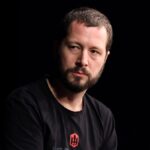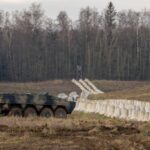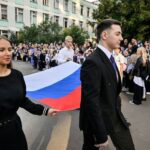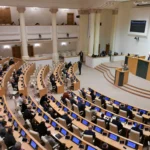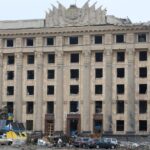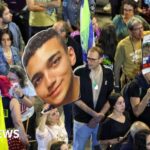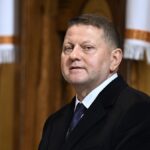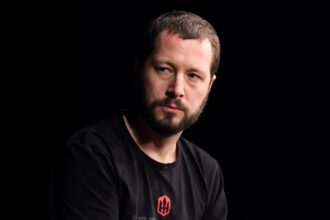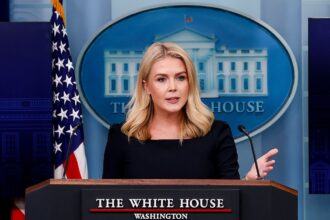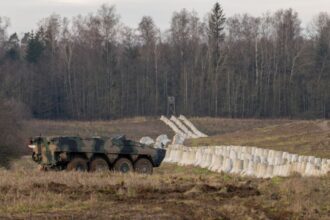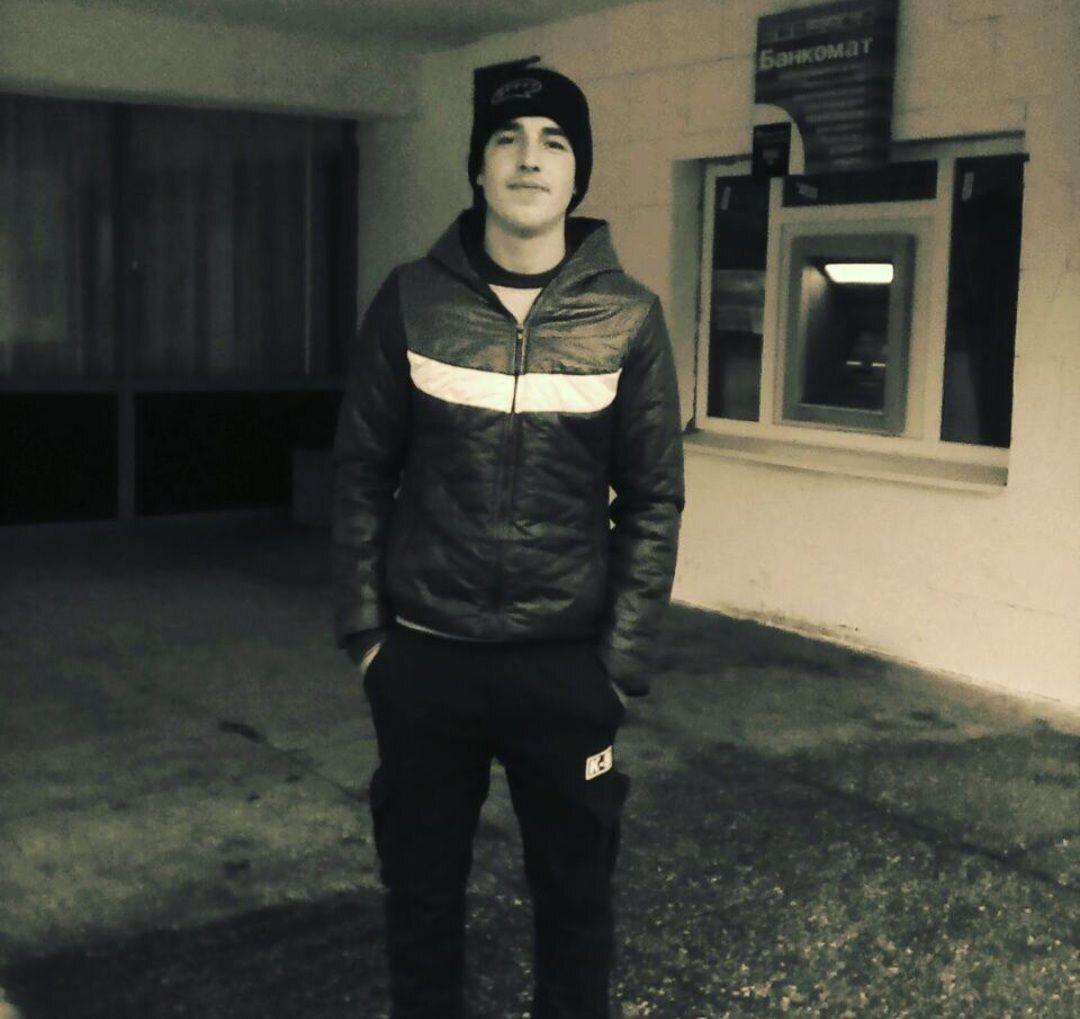To illustrate: A view of the Dnipro River from Kyiv, Ukraine. Dnipro, which separates the Russian occupied east bank from the Ukrainian controlled west bank in Kherson Oblast, is thousands of kilometers to the south. (The Kyiv Independent).
In the morning of November 20, 2023, Russians searched for Ruslan, a 28-year-old boy, at Raisa Rusnak’s home. Four masked men beat him and threw him to the ground.
What have I done to you, guys? What do you expect from me? Ruslan shouted. Raisa’s son said those last words to her. She never saw him again.
Eight days later she identified his corpse at the morgue. She was told he died from internal bleeding caused by a stomach ulcer while being interrogated by the Russian occupation Police. The woman is convinced her son was tortured and killed. Even the official Russian death certificates state that Ruslan died the day after his detention – a week before the woman was informed of Ruslan’s death.
“He was lying there… his eyes were open and his teeth were showing. He must have died in such agony. “I can’t imagine what my child went through,” Raisa said.
Ruslan was questioned at the former Ukrainian Police Station in the town Hornostaivka on the east bank of the Dnipro River, in the Russian occupied part of Kherson Oblast. Moscow has controlled the territory since 2022. Hornostaivka was occupied by the Russians in April 2022. The town had a population of 6,500 before the war. Raisa fled the town in early 2024 for territory controlled by Ukraine.
The Russian occupation police has been operating in the police HQ on Torhova Street, Hornostaivka where Ruslan is held, for the past two and a quarter years. In this building, the occupiers set up a torture room. Ruslan was one of many Ukrainians who were taken there by the Russians, and he is not the only one to have died. The fate of many other Ukrainians remains unknown.
Russia has terrorized local populations in torture chambers in the occupied territories. Previous reports indicate that this tactic was used in Kharkiv, Zaporizhzhia, and the previously occupied Kherson Oblast.
Oleksandr slisarenko is one of the missing, a local entrepreneur in Hornostaivka and a volunteer. His wife left when the Russians took over the town, but he stayed to help others.
“He was responsible to a lot people. He couldn’t leave them. “Maybe you could be here?” I would ask him. He would say ‘no’, ‘I cannot leave those grannies’. His wife Liudmyla remembers him saying, “It will get better soon.”
Liudmyla lives in Poland. Since leaving Hornostaivka, in April 2022 she has kept in touch by phone and messenger applications with her husband. On Aug. 3, 2022 the connection was cut: the occupying forces took Oleksandr that morning.
“He went outside to do some chores – he came back in the same clothes that he slept in. You could say that our house was already surrounded. He was tortured after they tied his hands and put him on his back. He was severely beaten on the spot. Witnesses witnessed it all. “He was then thrown in a minibus, with a bag on his head,” Liudmyla said.
Oleksandr lost his trail from that moment. Liudmyla doesn’t even know if Oleksandr was taken to the Torhova Street police station. She does know, however, that Russians are known to torture, imprison and kill people in the Torhova Street police station.
Liudmyla informed the Kyiv Independent, that Volodymyr Rutschka, a driver for the local health inspection service is another victim of the Russian occupiers. In the first year, he was also taken to a police station on Torhova Street.
“He said something that they didn’t like. They beat him up at the police station. He was beaten and released, but he died the following day.”
We heard similar stories from residents of Hornostaivka, who were able leave. Interviewing these witnesses is currently the only way to find out about Russian war crimes committed in the occupied territory. The east bank of Kherson Oblast, which is under tight control and only Russians can access it, is not open to anyone else, including independent law enforcement agencies or documentarians or journalists.
In the course our investigation into Russian terror on the occupied territories we interviewed dozens people who had managed to leave – some as recently as summer 2024. They either requested anonymity or refused interviews out of fear for the Russians. Most of them still have relatives or close friends in the occupation, who could be retaliated against for their testimonies.
Torture chamber in Hornostaivka
A woman from Hornostaivka reported to the Kyiv Independent a similar story to that of Volodymyr Rutschka that occurred in the summer 2023 with Serhii Kopot.
“He was taken straight from the market. He was dragged out of the market store, thrown into a minibus and two days later he was dumped in his yard. His neighbors picked up the man. Two days later, he died. She said that he was severely beaten.
She also claimed that a group, including a Russian police officer who introduced himself as “Vladimir”, threatened to kill her if she did not follow Klopot’s example.
According to her, the Russians persecuted mainly former Ukrainian soldiers and weapon owners. Any person who expressed a pro Ukrainian position was also at risk. Other witnesses, however, said that the Russians terrorized business owners and threatened to take their property. This was a common practice in the first year of occupation.
“Those who have businesses were detained to ransom and so forth.” It was always the same: you brought money, and they let you go. Henadii Khryzhanovskyi is an entrepreneur who spoke to us in confidence. “People’s cars were stolen at night, they broke into garages, drove cars away and houses were robbed,” he said.
Kryzhanovskyi was also held in the building at Torhova Street, in the fall 2022. He was only released after signing a statement regarding the transfer of his vehicles for the so-called “special operation” of Russia. He was only able to leave occupied territory in July 2024.
Kryzhanovskyi wasn’t the only Russian forced to “voluntarily” surrender his property. Oleksandr maltsev, pastor of the Baptist Church in Hornostaivka was also forced to “voluntarily” give up his property. In the fall 2022, Russian troops searched the church and Maltsev was taken to Torhova Street. He spent just over two weeks in prison and was forced to sell his two cars.
Residents of Hornostaivka told us that not only people from the town, but also from nearby villages and towns, and even from Kakhovka or Nova Kakhovka located tens and tens kilometers away, were taken to the police station in Torhova Street and held there.
Olha (named changed) from the village Kairy, located eight kilometers from Hornostaivka said that the Russians took residents of her town to the police station at Torhova Street.
“They abducted, tortured and beaten people. As far as I am aware, these people were electrocuted. They tortured them in this way because they (Russians), wanted to show that they were the masters, and we were the simple folk who had to obey them. “They’ve tried it all, except for putting electrodes underneath the nails,” said a woman who left Kairy during the summer of 2024.
Olha said that Russians can punish Ukrainians for saying “Glory To Ukraine,” which is a Ukrainian salute.
“One man was grabbed by the arms and taken to safety. A week or so later, we learned that he had been found and killed. Another woman was celebrating her birthday. She was a bit drunk and went to the store. She said, “Glory to Ukraine! Glory to Heroes!” The Russian soldiers stared at each other and did not touch the woman at first. The woman was just about to leave the shop when they grabbed her by the arms and stuffed it into a car.
All the testimonies that we have gathered paint a picture a systemic terror whose epicenter is the torture chamber at Hornostaivka. This terror began in August 2022 and continues today. Ruslan Rusnak was not the only Russian taken in the town in November 2023. He was likely tortured to his death on Torhova Street. In the same month, Denys Shum and brothers Ivan Shtepa and Anton Shtepa were also held there. It is unknown where they are.
The Faces of Russian Terror
Ruslan Rusnak’s death and the terror that he caused in the local community allowed us to identify those Russian police officers who were involved. In February 2024, a Russian anonymous Telegram channel reported that Russian law enforcement agencies were prosecuting Hornostaivka police officers for “abuse” of office in connection with Ruslan Rusnak’s death. The message included their names and initials.
Andrey Polevshchikov was the head of Russian police in occupied Hornostaivka when Ruslan Rusnak died. In a video taken in the town in August 2023, a man who looks very much like him can be seen. In October, he talked to a Russian propaganda outlet about the work done by the police.
“Citizens like to work with the police, because they see them as a helping force. In the video, Polevshchikov says that initially, the population was cautious about police officers. But, when they saw us in action, they were welcomed.
Other names mentioned in the anonymous Telegram message were “V. Pliukhin” and “V. Merkurov”, I. Pimenov and A. Denisov.” We were able identify Russian policemen Igor Pimenov, and Vasily Merkurov, but we found no confirmed link to Hornostaivka.
In the case “V. Pliukhin”, we decided to use the name “Vladimir”, (“Volodymyr” is Ukrainian) in order to represent “V,” as several residents of Hornostaivka had given us this name because of the terror of Russian officers. Volodymyr pliukhin is a former Ukrainian officer from Zaporizhzhia Oblast, who defected to Russia during the full-scale invasion. In the video, Polevshchikov mentions, among other things that a Zaporizhzhia Oblast police officer has joined the Hornostaivka Police Station.
We showed a picture of Volodymyr pliukhin that we found on the Internet to several residents of Hornostaivka. Two of the residents recognized the policeman who was involved in the terror that took place in the town. One witness said that this was the “Vladimir”, who had threatened her with the fate Serhii Klipot, who was tortured and killed. Another witness, who was in prison at the Hornostaivka police station, told us this man was guarding captives on Torhova Street, in December 2022, and that he said he was from Zaporizhzhia Oblast.
We also learned about the progress of the “abuse-of-office” charge brought against these policemen. Polevshchikov was contacted under the guise of an association of ex-Russian police officers. We offered to help him. He told us the case was opened on February 1, 2024. This is almost two and half months after Ruslan Rusnak died. Polevshchikov says that he does not need any assistance.
The case has been suspended. The case will be terminated because of the injury. I signed a contract (military), and I joined the “special military operation.” I’m already home with an injured arm and a leg. Polevshchikov said in a telephone conversation that they had discovered a landmine.
He said that all of the employees of the Russian-run Hornostaivka Police Station who were prosecuted in this case joined the military with him and were wounded in combat.
By signing contracts for participation in the Russian-Ukrainian War and being “wounded on action”, the Russian policemen of Hornostaivka avoided any responsibility in Ruslan Rusnak’s death.
When Raisa learned that the Russian police were investigating her son’s death she didn’t believe in Russian justice. “I don’t think it was anything more than a pretense,” she told us.
The official Ukrainian investigation is also not likely to yield any positive results. The law enforcement officers are unable to enter the occupied territories, they do not have access to bodies for forensic examinations and they cannot interview witnesses on-site. Interviewing those who have escaped is difficult because they face the same problem as journalists and documentary makers: people are afraid to testify.
The Russian terror continues to rage on the occupied east side of Kherson Oblast. Even though some residents have been lucky enough to escape, it is notoriously hard for Ukrainians to leave occupied territory. Ruslan Rusnak attempted to leave in 2022 but was refused entry by the Russians because of his previous service in the Ukrainian Armed Forces. Hennadii kryzhanovskyi was able to leave Hornostaivka on his second try.
Olha, a woman from Kairy, managed to escape with her husband and two children. While crossing the border, Russians beat and threatened her husband with murder and her sexual violence.
Even those who leave occupied territories are often traumatized by Russian terror, whether they themselves have suffered it or their family and friends have.
Liudmyla said that she thinks constantly about her husband whose fate is unknown since more than two years. “My grandson grows up. His other grandfather is dead. “I want Oleksandr’s grandson to grow up,” she said barely holding back her tears.
Raisa Rusnak’s nightmares are the result of the Russian occupation terror that took her son, home and justice.
“I moved into my daughter’s house and have not let her rest. I have cried all day and all night. I imagine that they are killing my daughter, and I am scared. In my dreams, I see my daughter or second son being taken away. And I scream in the night, I disturb everyone. I cry and scream in the night. That’s it.”
Danylo Mokryk works as a reporter for the Kyiv Independent’s War Crimes Investigations Unit. He was previously an investigative reporter with Bihus.Info. His 2022 investigation of Russian genocide in Ukraine was awarded the “Honor of the Profession”, Ukrainian journalism award. In the same year, his investigation of the deliberate killings by Russian soldiers of Ukrainian children was shortlisted for MezhyhiryaFest’s Investigative Journalism Award. Before the full-scale Russian invaders, he won several awards and nominations in recognition of his investigations into corruption in Ukraine.
Read More @ kyivindependent.com
